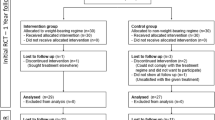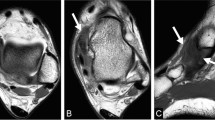Abstract
Background
It is unclear whether isolated gastroc/soleus tightness can increase the risk of lower extremity injury in an otherwise healthy child.
Questions/Purposes
(1) Is there a difference in gastroc/soleus tightness, as represented by ankle dorsiflexion with the knee extended, in children presenting with upper versus lower extremity complaints? (2) Is there a difference in gastroc/soleus tightness in children presenting with atraumatic versus traumatic lower extremity complaints?
Methods
We performed a cross-sectional study of 206 consecutive walking age children presenting to a county orthopedic clinic with new upper or lower extremity complaints. Passive ankle dorsiflexion was measured based on the lateral border of the foot versus the anterior lower leg with the knee fully extended and the foot in inversion.
Results
Average age was 10.0 ± 4.5 years. In the 117 patients presenting with upper extremity complaints, ankle dorsiflexion was 15.0° ± 11.6°. Of the lower extremity patients, 40 presented without trauma, with dorsiflexion of 11.8° ± 14.5°, while 49 presented with trauma, with dorsiflexion of 6.5° ± 12.0°. Multiple regression analysis found significantly decreased ankle dorsiflexion with increasing age and in the lower extremity trauma group. Twelve percent of upper extremity patients had 0° or less of dorsiflexion, as compared to 25% of lower extremity nontrauma patients and 41% of lower extremity trauma patients.
Conclusions
Patients presenting with lower extremity trauma had significantly more gastroc/soleus tightness in their well leg than patients presenting with upper extremity complaints. Gastroc/soleus tightness may present a simple target for reducing lower extremity injury rates in children.


Similar content being viewed by others
References
Aronow MS, Diaz-Doran V, Sullivan RJ, et al. The effect of triceps surae contracture force on plantar foot pressure distribution. Foot Ankle Int. 2006; 27: 43-52.
Backer K, Kofoed H. Passive ankle mobility. Clinical measurement compared with radiography. J Bone Joint Surg (Br). 1989; 71: 696-8.
Barske HL, DiGiovanni BF, Douglass M, et al. Current concepts review: isolated gastrocnemius contracture and gastrocnemius recession. Foot Ankle Int. 2012; 33: 915-21.
Bowers AL, Castro MD. The mechanics behind the image: foot and ankle pathology associated with gastrocnemius contracture. Semin Musculoskelet Radiol. 2007; 11: 83-90.
Charles J, Scutter SD, Buckey J. Static ankle joint equinus: toward a standard definition and diagnosis. J Am Podiatr Med Assoc. 2010; 100: 195-203.
Cohen JC. Anatomy and biomechanical aspects of the gastrocsoleus muscle. Foot Ankle Clin. 2009; 14: 617-26.
de Noronha M, Refshauge KM, Herbert RD, et al. Do voluntary strength, proprioception, range of motion, or postural sway predict occurrence of lateral ankle sprain? Br J Sports Med. 2006; 40: 824-8.
DiGiovanni CW, Kuo R, Tejwani N, et al. Isolated gastrocnemius tightness. J Bone Joint Surg Am. 2002; 84: 962-70.
DiGiovanni CW, Langer P. The role of isolated gastrocnemius and combined Achilles contractures in the flatfoot. Foot Ankle Clin. 2007; 12: 363-79.
Grady JF, Saxena A. Effects of stretching the gastrocnemius muscle. J Foot Surg. 1991; 30: 465-9.
Johnson E, Bradley B, Witkowski K, et al. Effect of a static calf muscle-tendon unit stretching program on ankle dorsiflexion range of motion of older women. J Geriatr Phys Ther. 2007; 30: 49-52.
Mahieu NN, Cools A, DeWilde B, et al. Effect of proprioceptive neuromuscular facilitation stretching on the plantar flexor muscle-tendon tissue properties. Scand J Med Sci Sports. 2009; 19: 553-60.
Martin RL, McPoil TG. Reliability of ankle goniometric measurements: a literature review. J Am Podiatr Med Assoc. 2005; 95: 564-72.
Matjacic Z, Olensek A, Bajd T. Biomechanical characterization and clinical implications of artificially induced toe-walking: differences between pure soleus, pure gastrocnemius, and combination of soleus and gastrocnemius contractures. J Biomech. 2006; 39: 255-66.
Natarajan R, Ribbans WJ. Achilles Tendon Involvement in Pediatric Conditions. In: Maffulli N, Almekinders LC, eds. The Achilles Tendon. New York, NY: Springer; 2007: 236-51.
Orendurff MS, Rohr ES, Sangeorzan BJ, et al. An equinus deformity of the ankle accounts for only a small amount of the increased forefoot plantar pressure in patients with diabetes. J Bone Joint Surg (Br). 2006; 88: 65-8.
Pope R, Herbert R, Kirwan J. Effects of ankle dorsiflexion range and pre-exercise calf muscle stretching on injury risk in Army recruits. Aust J Physiother. 1998; 44: 165-72.
Radford JA, Burns J, Buchbinder R, et al. Does stretching increase ankle dorsiflexion range of motion? A systematic review. Br J Sports Med. 2006; 40: 870-5.
Author information
Authors and Affiliations
Corresponding author
Ethics declarations
Conflict of Interest
Raymond W. Liu, MD, reports other from Orthopediatrics Corp., outside the work. Katherine K. Xie, BS, declares that she has no conflict of interest.
Human/Animal Rights
All procedures followed were in accordance with the ethical standards of the responsible committee on human experimentation (institutional and national) and with the Helsinki Declaration of 1975, as revised in 2008 (5).
Informed Consent
Informed consent was waived from all patients for being included in the study.
Required Author Forms
Disclosure forms provided by the authors are available with the online version of this article.
Additional information
Level of Evidence: Prognostic Study Level II
Rights and permissions
About this article
Cite this article
Liu, R.W., Xie, K.K. Association between Achilles tightness and lower extremity injury in children. HSS Jrnl 12, 245–249 (2016). https://doi.org/10.1007/s11420-016-9506-8
Received:
Accepted:
Published:
Issue Date:
DOI: https://doi.org/10.1007/s11420-016-9506-8




